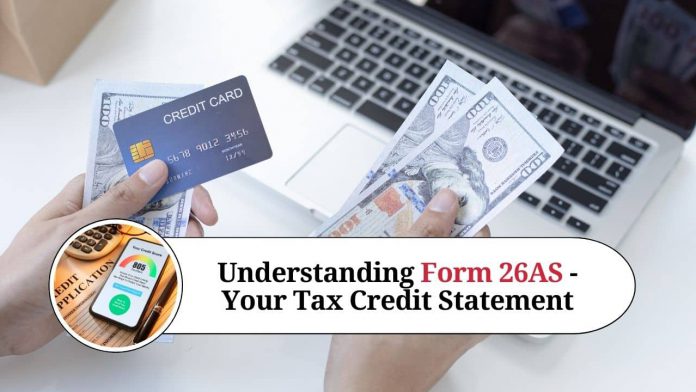Form 26AS is an essential document that every taxpayer in India should be aware of. It is an annual statement that summarizes all the taxes paid by you and the taxes that have been deducted from your income by various entities such as your employer, banks, or any other deductor. The Income Tax Department of India issues this document to assist taxpayers in filing their tax returns correctly. In this article, we will discuss everything you need to know about Form 26AS.
What is Form 26AS?
Form 26AS is a consolidated tax statement that reflects all the taxes paid by an individual or entity. It is a vital document that summarizes all the tax-related information, including tax deducted at source (TDS), tax collected at source (TCS), advance tax, and self-assessment tax. This statement also provides information about the taxpayer’s PAN (Permanent Account Number), tax payments, and tax refunds.
The purpose of Form 26AS is to help taxpayers verify the taxes paid and taxes deducted from their income. It serves as an essential document for filing income tax returns (ITR) and for claiming refunds. The statement is available on the Income Tax Department’s website and can be accessed by entering the taxpayer’s PAN and password.
Components of Form 26AS:
Form 26AS contains several essential components that provide a comprehensive view of the taxpayer’s tax credit statement. These components include:
- Part A – Details of Tax Deducted at Source: This section provides information on TDS deducted by various entities, such as an employer or bank. It also provides details such as the name of the deductor, the TDS amount, and the date of deduction.
- Part A1 – Details of Tax Deducted at Source for Form 15G/15H: This section provides details of TDS deducted on interest earned from banks, post offices, or any other entity. It is applicable for taxpayers who submit Form 15G or Form 15H to declare that they are not liable to pay tax on their income.
- Part A2 – Details of Tax Deducted at Source on Sale of Immovable Property: This section provides details of TDS deducted on the sale of immovable property.
- Part B – Details of Tax Collected at Source: This section provides information on TCS collected by various entities, such as an e-commerce platform or a seller.
- Part C – Details of Tax Paid: This section provides information on the advance tax and self-assessment tax paid by the taxpayer.
- Part D – Details of Paid Refund: This section provides details of the refund received by the taxpayer.
- Part E – Details of AIR Transactions: This section provides information on high-value transactions made by the taxpayer, such as the purchase or sale of a property or a vehicle.
- Part F – Details of Tax Deducted on Interest other than Salary: This section provides details of TDS deducted on interest earned from sources other than salary, such as fixed deposits or recurring deposits.
Final Conclusion
In conclusion, Form 26AS is an essential document that every taxpayer in India should be familiar with. It helps in verifying the taxes paid and taxes deducted from the income, reducing the chances of errors in tax filing. Taxpayers must regularly check their Form 26AS to ensure that they are filing their taxes correctly and claim refunds if necessary.
Other Related Blogs: Section 144B Income Tax Act
Frequently Asked Questions:
Q:1 What is Form 26AS?
A: Form 26AS is a consolidated tax statement that contains details of all the taxes deducted or collected on behalf of a taxpayer and deposited with the government by the deductor or collector.
Q:2 Who issues Form 26AS?
A: Form 26AS is issued by the Income Tax Department of India.
Q:3 What information does Form 26AS contain?
A: Form 26AS contains information on tax deducted or collected on behalf of the taxpayer, details of advance tax and self-assessment tax paid details of tax refunds, and other details such as TDS certificates, details of high-value transactions, etc.
Q:4 Why is it important to check Form 26AS?
A: It is important to check Form 26AS to ensure that all the taxes deducted or collected on behalf of the taxpayer have been deposited with the government, and to verify the accuracy of the tax credit reflected in the form.
Q:5 How can I access Form 26AS?
A: Form 26AS can be accessed online through the Income Tax Department’s e-filing portal or the taxpayer’s internet banking account.
Q:6 What is the due date for issuing Form 26AS?
A: Form 26AS is updated every quarter, and the due date for issuing the same is 31st May, 15th August, 30th November, and 15th February for the respective quarters.
Q:7 What should I do if there is any discrepancy in Form 26AS?
A: If there is any discrepancy in Form 26AS, the taxpayer should immediately contact the concerned deductor or collector to rectify the same, and also update the details in their income tax return.
Q:8 Can I revise my income tax return based on the information in Form 26AS?
A: Yes, the taxpayer can revise their income tax return based on the information in Form 26AS if there is any discrepancy or if they have missed reporting any income.




















